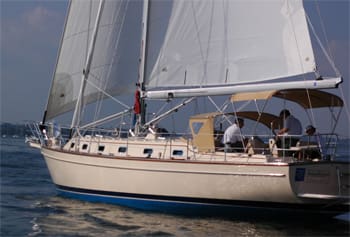The mainsail is the big dog in a modern sail plan and when it comes to setting, dousing and reefing a crew needs to be able to cope with the increased sail area. Smoother sliding tracks and cars, hammock like “stack packs” and lazy jacks or a Dutchman system can help the shorthanded crew cope with the mainsail of a 40- to 45-footer. But the bigger the sail becomes, the more fit and agile the sail handlers must be.
In answer to the challenge of making larger cruising boats easier to handle, innovators like Ted Hood and sailors and engineers at Selden, Schaefer and others turned to roller furling approaches to tame the main. It all began with headsail like furling systems being strung up on the trailing edge of the mast. These early innovations proved to be inadequate, and it was Hood’s Stoway in-mast furling system that finally brought mainsail furling to the mainstream. The concept of winding the mainsail on a mandrel inside a spar may seem like an ideal solution, and it would be if a mainsail was as flat as a bed sheet and side loads didn’t count.
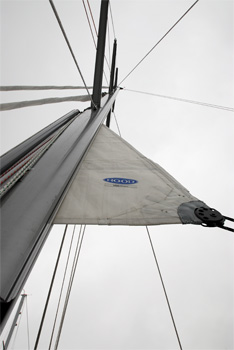 |
|
A main emerging from the mast slot. |
Unfortunately, broad seaming puts the aerodynamic shape in the mainsail and rolling up cloth that’s not designed to lay flat can create bulges and pinches of sail material that can jam or bind during the furling or unfurling process. In order to lessen the chance for such unnerving encounters, sailmakers have learned to shape furling mainsails much flatter and build them with a hollow roach. Both of these solutions cause performance oriented sailors to cringe, but in-mast furling advocates point out that by being able to dial in just the right amount of mainsail area sail draft short falls can be mitigated. This is true to some extent, but the one area where the draft and roach shortfall is really missed is in lighter air conditions where every sailboat benefits from a deep draft mainsail.
Conceptually, retracting a mainsail inside a mast is a process that’s much easier to describe than to engineer. The slotted foil or mandrel in the center of the spar must remain in column as the side load of the furling process attempts to pull it aft. Bearings at the top and bottom allow the torque producing mechanism at the base to wind up the sail without “barber poling” or twisting the luff slot. The spar must also provide for rigging attachments, spreader connections, and electrical wire runs, and still resist the compression and bending loads caused by the interplay between mainsail heeling forces and the vessel’s righting moment. The energy transferred from the luff to the mandrel is not as evenly transferred along the trailing edge of the spar as it is with a conventional mainsail track. Loads focus at the top and bottom attachment points and the spar must be designed to handle the new load path.
Early efforts even suffered from unintended challenges such as the harmonic whistling that can test the patience of a crew and their marina berthed neighbors. In the early years, with a hand both in spar building and sailmaking, Hood was better positioned than anyone else to develop a successful system, and in doing so he captured a new market in sailboats ranging from 35-footers to megayachts.
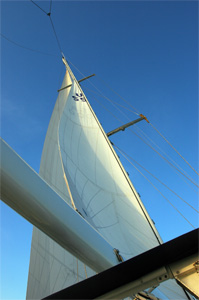 |
|
Advantages of an in-mast system is a smaller boom and the ability to fine-tune the sail area deployed to match wind strength. |
The in-boom approach
In order to solve the no battens, minimized-draft issue, mainsail furling systems based on the boom, rather than the mast, hit the market. The big upsides with this option are the abilities to utilize a high-performance bendy carbon spar and a big roach fully-battened high-performance mainsail. Another is the system’s fail safe capacity that allows a crew to manually drop the main even if problems arise in the boom furling system itself. On the other side of the coin lies a heavier, thicker cross section boom and a luff feed track that needs careful attention when hoisting or reducing sail.
The breakthrough in boom-based furling technology came from Hood once again, this time stemming from his interest in improving the aerodynamics of a furling mainsail. His Stoboom furler was another iteration of window-shade engineering, but in this case the wind-up action takes place around an in-boom furler rather than an in-mast one, and the mainsail is hoisted via a conventional halyard system. An electric or hydraulic winch usually provides the hoisting power, but care must be taken to make sure all aspects of the furling system are aligned and behaving appropriately. The two big pluses in this rendition of mainsail furling gear are the fully-battened, big-roach mainsails that can be accommodated and the operational flexibility of the system — even if the furler fails, the sail can be lowered in the conventional fashion. The downsides are the heavy, large-diameter boom and the snag-prone transition the sail’s luff must make from its fully rolled-up boom stowage to the track on the trailing edge of the spar.
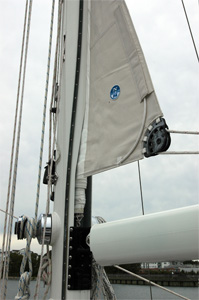 |
|
One engineering challenge of in-mast furling is to keep slotted foil or mandrel in the mast from flexing too much due to side loads. |
The smooth operation of these systems depends on a few distinct variables. The most obvious is the design and engineering quality of the equipment, and the industry has done a pretty good job of picking the right materials for component parts and building the gear with repeatable quality control. Each design seems to have its own strengths and contingent small set of weaknesses, the latter being quick to surface when users fail to operate the system optimally. Operational problems can often be traced to the installation, including whether or not the unit is the right size for the vessel. Vessel length is only a starting point for gauging the gear to be selected. Equally as important is the type of cruising that will be undertaken and how hard and how long the vessel will be driven by her crew. The higher and more prolonged the sailing load, the more willing a sailor should be to choose the next larger unit, especially if his or her boat is near the upper end of the size range for the unit under consideration. And the installer needs to be familiar with the nuances of the gear; it’s usually better to contract a rigger who’s a rep for the product.
A few basic rules
When you’re setting sail with in-mast or in-boom furling, following a few basic rules can avoid significant problems. The most obvious but most often neglected precaution is to make sure you or some member of the crew is watching the sail as outhaul and inhaul systems are actuated. This is even more imperative when button pushing replaces winch grinding. The latter provides direct feedback, and increased resistance is an early warning that a line is not running freely. The motor on a power winch is non-intuitive, however, and will continue to tension a line until either the switch is released, a circuit breaker pops or something breaks. There’s no recognition of a hockle in an inhaul line or a luff tape that has just pulled out of the mainsail track. The same plight faces operators of heavy equipment, and their training stresses visual confirmation of what’s happening around them. Absentmindedly pressing an electric winch button can turn a convenience into a catastrophe.
I recall a sail up Lake Michigan aboard the Harken 60-foot prototype Procyon. The huge freestanding furling mainsail was being deployed when the inhaul line jammed as the outhaul power winch continued to operate. In little more than a second or so, tension increased to the point of tearing the clew and all its reinforcement off the sail. During a trans-Atlantic crossing, the crew of a sloop named Harmony II had a similar issue develop when water got into the furling relay box and short-circuited an electric winch, leading to mainsail damage and a small electrical fire. Many savvy skippers have taken the precaution of having an emergency “kill switch” installed in the cockpit in case a power winch malfunctions.
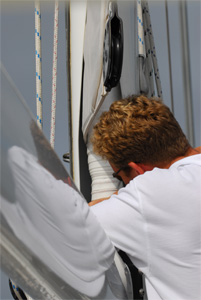 |
|
With in-mast furling systems, a jammed sail can be difficult to reach inside the spar. |
Large, shiny power winches turn slowly and seem pretty benign, especially when the power is off. But once engaged, they exert tremendous torque and if a piece of clothing or a hand is caught under the line wrapping around the drum, serious injury can result. However, with a little extra vigilance, a power winch can be as useful and welcome as an extra crewmember.
Another key factor in getting along with a modern mainsail furling system is to make sure the sail is neither wildly flogging nor powered up while it is being set or doused. The game plan is to find the sweet spot between these extremes by controlling the sail’s angle of attack via sheeting as well as steering. A head-to-wind attitude reduces the angle of attack to zero and de-powers the sail, but falling off just a little will cause the mainsail to begin to fill and power up. Easing the mainsheet and steering slightly to one side or the other of head to wind is also an option. If the sail is furled or unfurled while powered up, problems are more likely to develop.
In-mast tension required
In-mast furling systems need a small amount of tension on the outhaul as the main is rolled into the spar. This keeps the furled sail compact and prevents loose sail material from jamming in the mast cavity. A crucial aspect in handling in-boom furlers revolves around the tension and feed angle of the luff tape as it ascends toward the track at the gooseneck. If too much tension is placed on the halyard and the sail binds in the boom or its furling line is not eased smoothly, an excessive load can be placed on the feed point of the track and damage can occur. This problem can be exacerbated if the crew does not watch the feed and a powerful electric or hydraulic winch is doing the work. If a large dodger or a pilothouse obscures the view of the mainsail, it makes sense to move the control lines and pushbuttons for a better view.
It’s also important to work with your sailmaker to optimize a new mainsail for the furling system you intend to use. Boom furlers allow the sail to incorporate full horizontal battens, a sizable roach, and more draft than an in-mast mainsail can carry, but the battens must be kept parallel to the rotation axis of the in-boom foil, and the furled sail diameter must fit inside the boom cavity. An in-mast roller-furling mainsail should be made of stiffer yarn-tempered polyester or a higher-modulus material that resists wrinkling. The material, panel pattern, and location of chafe patches on the sail can also be optimized for the furling system.
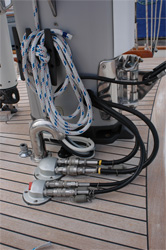 |
|
An in-mast system driven by hydraulic power makes furling a one crewman job, even with large sails. |
Associated gear considerations
Associated equipment such as the boom vang, topping lift or other boom support also becomes strategically important, especially with an in-boom furler which relies on careful control of the mast-to-boom angle. As this angle varies above or below 90 degrees, the luff of the sail feeding into the track tends to move forward or aft in the boom cavity. For some time, owners of Hood’s Stoboom swore that 86 degrees was the optimum mast-to-boom angle, providing good foot tension during furling and maintaining a good lead angle for the hoist. The best boom angle for your system goes hand-in-hand with developing the right halyard tension on the luff as the sail feeds into the track.
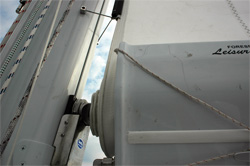 |
|
Pre-feeding the luff into the sail track is key to raising the main cleanly. |
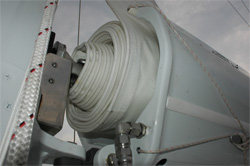 |
|
An in-boom system, note boom size to fit sail. |
In-mast furling is not as sensitive to a few degrees of boom angle one way or the other, and given the negligible roach in the sail, a topping lift is often ample boom support. Mast bend is incompatible with in-mast furling, however — the primary problem being that spar curvature causes the rotating luff rod to contact the slot walls at mid-luff. In extreme cases the rotating foil and part of the mainsail can end up getting jammed in the slot.
Vertical battens allow an in-mast furling mainsail to sport a positive roach, but they also increase the chances of a hang-up in the furling or unfurling process. If the vertical battens are lengthy and a furling problem occurs at sea, you can imagine what it would be like to douse the mainsail. If you choose in-mast furling, consult with your sailmaker about a no-roach mainsail made of stiffer cloth and cut specifically for the furling system. And if boom furling is your preference, keep an eye on the all critical short run of track that leads the luff of the mainsail from the boom to the spar track.
Nothing aboard a sailboat is quite perfect, but mainsail furling has made great strides and earned a “refined and reliable” rating. It’s a sailhandling trend among cruisers that continues to grow.
—————
Ralph Naranjo is a circumnavigator and freelance marine writer and photographer based in Annapolis, Md. He is the author of the books Wind Shadow West and Boatyards and Marinas.

